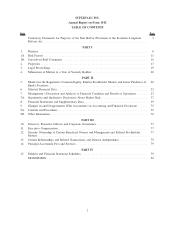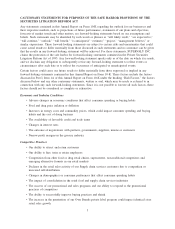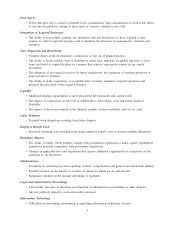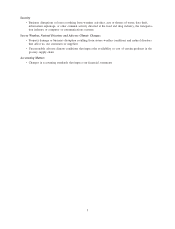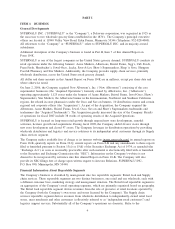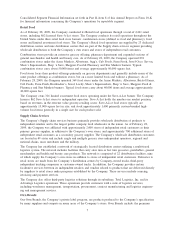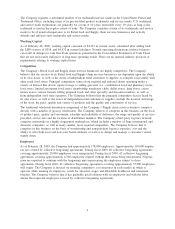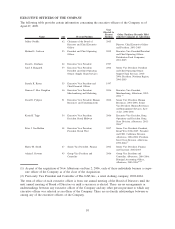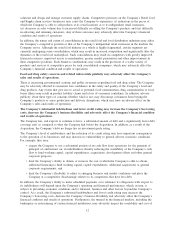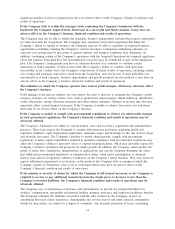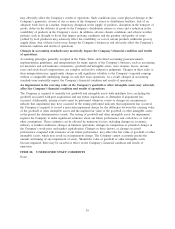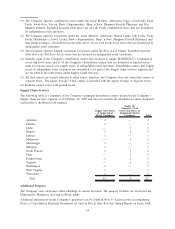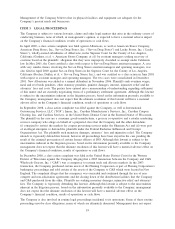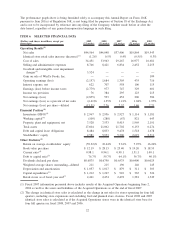Albertsons 2009 Annual Report Download - page 16
Download and view the complete annual report
Please find page 16 of the 2009 Albertsons annual report below. You can navigate through the pages in the report by either clicking on the pages listed below, or by using the keyword search tool below to find specific information within the annual report.solutions and design and manage customer supply chains. Competitive pressures on the Company’s Retail food
and Supply chain services businesses may cause the Company to experience: (i) reductions in the prices at
which the Company is able to sell products at its retail locations or to its independent retail customers,
(ii) decreases in sales volume due to increased difficulty in selling the Company’s products and (iii) difficulty
in attracting and retaining customers. Any of these outcomes may adversely affect the Company’s financial
condition and results of operations.
In addition, the nature and extent of consolidation in the retail food and food distribution industries may affect
the Company’s competitive position or that of the Company’s independent retail customers in the markets the
Company serves. Although the retail food industry as a whole is highly fragmented, certain segments are
currently undergoing some consolidation, which may result in increased competition and significantly alter the
dynamics of the retail food marketplace. Such consolidation may result in competitors with greatly improved
financial resources, improved access to merchandise, greater market penetration and other improvements in
their competitive positions. Such business combinations may result in the provision of a wider variety of
products and services at competitive prices by such consolidated companies, which may adversely affect the
Company’s financial condition and results of operations.
Food and drug safety concerns and related unfavorable publicity may adversely affect the Company’s
sales and results of operations.
There is increasing governmental scrutiny and public awareness regarding food and drug safety. The Company
may be adversely affected if consumers lose confidence in the safety and quality of the Company’s food and
drug products. Any events that give rise to actual or potential food contamination, drug contamination or food-
borne illness may result in product liability claims and a loss of consumer confidence. In addition, adverse
publicity about these types of concerns whether valid or not, may discourage consumers from buying the
Company’s products or cause production and delivery disruptions, which may have an adverse effect on the
Company’s sales and results of operations.
The Company’s substantial indebtedness and lower credit rating may increase the Company’s borrowing
costs, decrease the Company’s business flexibility and adversely affect the Company’s financial condition
and results of operations.
The Company has, and expects to continue to have, a substantial amount of debt and a significantly lower debt
coverage ratio as compared to what the Company had before the Acquisition. In addition, as a result of the
Acquisition, the Company’s debt no longer has an investment-grade rating.
The Company’s level of indebtedness and the reduction of its credit rating may have important consequences
to the operation of its businesses and may increase its vulnerability to general adverse economic conditions.
For example, they may:
• require the Company to use a substantial portion of its cash flow from operations for the payment of
principal of, and interest on, its indebtedness, thereby reducing the availability of the Company’s cash
flow to fund working capital, capital expenditures, acquisitions, development efforts and other general
corporate purposes;
• limit the Company’s ability to obtain, or increase the cost at which the Company is able to obtain,
additional financing to fund working capital, capital expenditures, additional acquisitions or general
corporate requirements; and
• limit the Company’s flexibility to adjust to changing business and market conditions and place the
Company at a competitive disadvantage relative to its competitors that have less debt.
In addition, the Company’s ability to make scheduled payments or to refinance its obligations with respect to
its indebtedness will depend upon the Company’s operating and financial performance, which, in turn, is
subject to prevailing economic conditions and to financial, business and other factors beyond the Company’s
control. As a result, the Company’s substantial indebtedness and lower credit rating may increase the
Company’s borrowing costs, decrease the Company’s business flexibility and adversely affect the Company’s
financial condition and results of operations. Furthermore, the turmoil in the financial markets, including the
bankruptcy or restructuring of certain financial institutions, may adversely impact the availability and cost of
12


